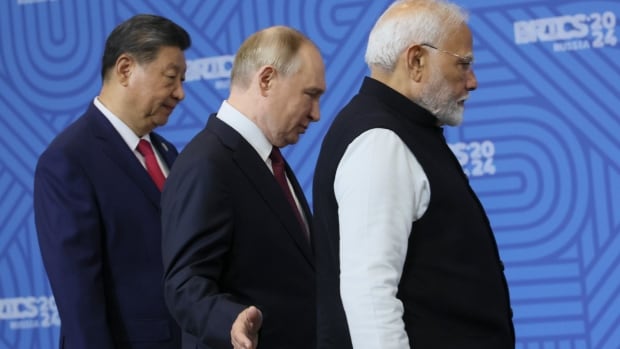A meeting Wednesday between India’s Narendra Modi and China’s Xi Jinping in Kazan, Russia, was the first in five years, and will likely be viewed with dismay in Washington, Ottawa and other Western capitals.
While it probably doesn’t mark the beginning of a new Beijing-New Delhi axis, it does seem to signal that India is not about to sign on to an anti-Beijing Western alliance either, despite the best efforts of the U.S. and some other countries to persuade it to do so.
“Would the U.S. be disappointed? I imagine,” said Sanjay Ruparelia, a close observer of the Modi government who teaches at Toronto Metropolitan University. “I don’t think publicly they would express it, but privately.”
Ruparelia said U.S. relations with India have always been complicated, and that complexity has always required the U.S. to split the relationship into silos.
“On the one hand, ties have grown despite many disagreements, and quite serious ones. The Russian invasion of Ukraine, most importantly,” he said.
“But you know, we’ve seen in the last year a new agreement on critical emerging technologies. You’ve seen growing defence and security partnerships. [U.S.] President Biden was reportedly the third leader in history to have his Indian counterpart at his own private residence. And that was this year — after the FBI foiled the plot to allegedly kill Mr. (Gurpatwant Singh) Pannun.”
Most recently, the U.S. signed a deal to sell India Predator drones, the primary weapons used by the U.S. in its own campaigns of extraterritorial killing targeting such groups as al-Qaeda and Islamic State.
“And I’m not surprised by that,” said Ruparelia. “I mean, the U.S. is the great power and they practice realpolitik more than any other power in the world.”
Ruparelia said that while he takes the RCMP’s statement that they have evidence linking agents of the Indian government to homicides and other acts of violence in Canada “seriously,” the U.S. government clearly has “compartmentalized the issue” in order to continue working with India.
Murder claims may take a back seat to larger issues
There are multiple factors at work in Modi’s decision to seek rapprochement with China. But the tensions with the West over India’s alleged program of assassinating dissidents in Canada and the U.S. could not have helped to sell him on the idea of ditching India’s traditional non-alignment and jumping into an alliance with the countries that have accused him.
At the same time, the geopolitical stakes between nations as large and powerful as the U.S., India, China and Russia all but ensure that the assassination allegations will end up taking a back seat to other, bigger considerations.
Russian President Vladimir Putin, host of this year’s BRICS summit, will be delighted with the meeting between Xi and Modi in Russia and may seek to take some of the credit.

Putin was careful to seat himself between the Indian and Chinese leaders, offering a visual symbol of his role as facilitator of their coming-together, said Prof. Ho-fung Hung of the Paul H. Nitze School of Advanced International Studies at Johns Hopkins University.
“This kind of photo-op meeting, in which Putin is showing up side by side with all these world leaders, is a win for Putin because it’s a kind of defiance of the U.S. attempt to isolate Russia,” he said. “Putin can show to people back home that actually [he has] friends, and Russia has friends, despite all these U.S. efforts. So the U.S. is failing in isolating Russia.”
Burying the clubs and hatchets
A brutal medieval battle fought at dangerously high altitude in June 2020 marked the lowest point in India-China relations in many years.
Twenty Indian and four Chinese soldiers were reported killed in a melee with clubs and axes over disputed territory high in the Himalayan district of Ladakh.
Both sides respected the letter of their agreement to keep guns out of their border dispute, although the peaceful spirit of that agreement was forgotten in brutal hand-to-hand fighting.
Since then there have been more incidents, including a similar brawl in December 2022 in Arunachal Pradesh, another mountainous stretch of the border more than 1,200 kilometres to the East.

The Chinese have paraded Indian prisoners before cameras, infuriating India and provoking street demonstrations.
China’s aggressive behaviour on India’s borders gave the Biden administration an opening that it seized to try to persuade India to sign up to a U.S.-led Indo-Pacific alliance aimed at countering China and Chinese expansionism.
Washington pointed to the parallels between India’s experience and that of the Philippines, Vietnam and other countries subject to extreme territorial claims by China that are often pushed using hardball methods.
For a while, it seemed to work. India signed up to a new “security dialogue” called the Quad, which united it with the U.S., Japan and Australia. But it soon became evident that India had little interest in moving past the dialogue stage.
‘Mutual trust, mutual respect’
This week, India and China announced that their border disputes were on the way to being settled, opening the door for Xi and Modi to meet in person.
“We are holding a formal meeting after five years,” said Modi. “We believe that the India-China relationship is very important, not only for our people but also for global peace, stability and progress. We welcome the consensus reached on the issues that have arisen over the last four years on the border.
“Mutual trust, mutual respect and mutual sensitivity should remain the basis of our relations.”
Not so fast, said Ruparelia, who is writing a book on how India and China — and relations between them — have changed under Modi and Xi.
“India hasn’t resolved the border dispute,” he said. “What they’ve agreed to do is to resume national patrols on either side of the dispute. In India, the media has been sort of euphoric, at least the pro-Modi media, but there haven’t been any details yet.
“And the biggest outstanding question is whether the status quo ante has been restored because China crossed the line of control and then occupied a lot of territory that India claimed at its own. It’s not clear whether they’ve retreated back to the line before the incursion in 2020.”
Still, the resolution to the border dispute suggests that China is willing to be more conciliatory with India than with other neighbours, in return for India remaining true to its non-aligned traditions and refusing to join any meaningful alliance against Beijing.
“India right now is in a very good position because everybody is calling India,” said Hung. “The U.S. definitely will be concerned about India getting too close with China.”
But India can afford to cause heartburn in Washington, he said, and the Modi government probably knows it has little reason to fear real consequences over the alleged Pannun assassination plot.
“I think that India has the upper hand in this relation now,” he said. “The U.S. really doesn’t have much leverage over India about all this.”

The U.S. federal indictment against Indian drug trafficker Nikhil Gupta at the end of last year brought into public view tensions that had already been building between Washington and New Delhi for months behind the scenes.
For the first time, it became clear that the U.S. was not merely backing the Trudeau government’s claim that it has evidence linking Indian agents to the killing of Canadian Sikh separatist leader Hardeep Singh Nijjar — it also had an alleged Indian government-sponsored murder plot on its own soil.
Pannun is the leader of a worldwide effort to organize referendums in the Sikh diaspora on the future of Punjab, pushing the idea of a Sikh homeland called Khalistan carved out of present-day India.
U.S. officials say they have a clear trail of electronic footprints leading back to the New Delhi headquarters of India’s intelligence service, the Research and Analysis Wing (RAW).
U.S. officials had little choice but to act on that evidence, even if it meant upsetting the budding relationship with India.

It soon emerged that President Joe Biden had himself raised the issue with Narendra Modi at the G20 Summit in New Delhi last year. Biden’s national security adviser Jake Sullivan has been tasked with managing the diplomatic aspects of a case the administration clearly wishes did not exist, but also cannot ignore.
Sullivan has met in recent months with both his Indian counterpart Ajit Doval, and with Modi himself, but has had to use some of that face-time to press India to investigate its own officials in the Pannun murder plot.
India has responded by claiming that rogue operatives were behind the conspiracy, setting up a commission of inquiry that travelled to Washington this month to report on its findings, and even placing one official under arrest.
Forced into such actions by the strength of electronic evidence in Washington’s hands, Modi has simultaneously been sending signals he is not interested in ostracizing either China or Russia. He visited Putin in a dacha outside Moscow in early July, to the annoyance of the U.S. State Department.
Russia ties run deeper
“It’s not the India-China relationship that the U.S. needs to be concerned about most, because India is also friendly with Russia,” said Hung.
India’s new agreement with China doesn’t resolve all issues between the two countries, including India’s fears about rising Chinese influence in countries that New Delhi has long considered part of its sphere of influence, such as Sri Lanka and Nepal.
India has few such structural impediments to its relationship with Moscow, said Hung.
“There’s evidence showing that actually India is also helping Russia in its war effort in one way or another.”
The allegations of murder plots against dissidents in Canada and the U.S. have highlighted one of the benefits of diplomacy with authoritarian regimes such as Russia and China: they don’t care how you treat your dissidents and they don’t give you lectures on human rights.
That understanding will likely temper U.S. pressure on India over the alleged assassination plots, in the same way that Washington has muted its criticism of India’s relationship with America’s rivals.
“There was the hope and expectation, I think, in some quarters in Washington that India will come on side more in the sense of therefore being more antagonistic towards China and Russia,” said Ruparelia.
“But India relies on Russia for more than two-thirds of its arms. Their artillery is very much dependent on Russia. India has always been concerned about growing ties between Russia and China. They’ve just had this border clash. So the U.S. would understand that.
“Even on the flashpoint of the Russian invasion of Ukraine, where India has been refining Russian oil and the U.S. probably is not happy about that, but at the same time, they have an interest in it because it helps keep the price of oil down, and therefore deals with inflationary pressures. So there’s a whole series of factors at work.”
Within all of that great power manoeuvring, the assassination plots do not loom very large. India knows that, and knows it occupies an enviable diplomatic position at the moment as the non-aligned player everyone wants on their team. And the experts say those geopolitical considerations are likely to trump all others






